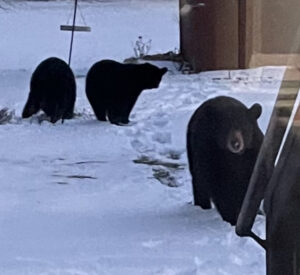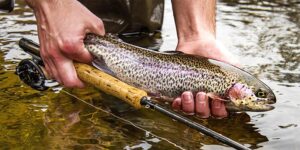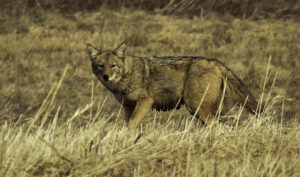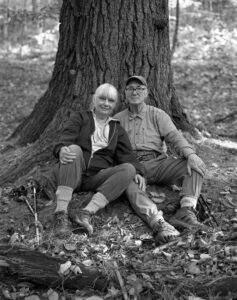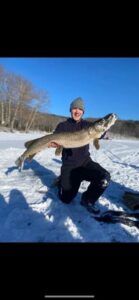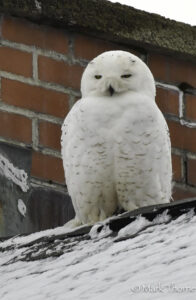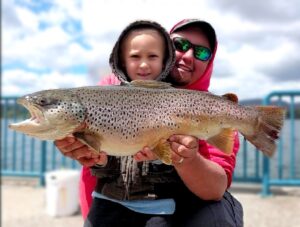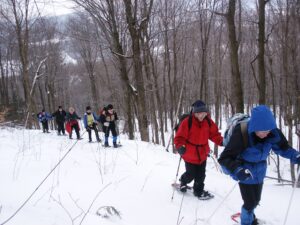MassWildlife officials are once again reminding the public that March is the month when hungry bears emerge from their winter dens and seek out food. If you live in Western Massachusetts, it’s time to take down your bird feeders. Natural foods such as acorns and other nuts are usually available on the ground, but last year’s fall hard mast crop was meager.
Bears will often ignore seasonally available natural foods including skunk cabbage in favor of an easy meal at a backyard bird feeder. Other species including wild turkeys and coyotes may also frequent bird feeders leading to a variety of nuisance issues.
MassWildlife advises property owners to avoid these problems by being proactive and remove bird feeders and other potential food sources including garbage or open compost. If you enjoy watching birds in your yard, MassWildlife suggests adding a water feature, growing native plants, shrubs, and trees to attract birds. Individuals should also secure bee hives, chickens, and livestock. Properly maintained electric fencing is the only way to protect chickens or bee hives from bears. Taking these actions may prevent the unnatural feeding of bears and other kinds of neighborhood wildlife.
There are at least 4,500 black bears in Massachusetts with approximately 2,000 of them living here in the Berkshires, and their range is expanding eastward. We must take action by educating ourselves and our neighbors about proactive measures to avoid conflicts with bears.
I should practice what I preach! My wife Jan and I enjoy feeding and watching the many birds visiting our feeders, and have been hesitant in taking them down because of the crazy spring weather this year. One day its springlike and the next day we are blasted with snowstorms and cold wintry weather. To lessen the possibility of bears raiding and in many cases destroying our suet feeders and holders, we have been bringing them into the house every night and putting them back out early each morning. Being retired and home a lot, we figured the bears wouldn’t dare bother our feeders in the daytime.
Well, one day last week, when Jan and I got home from a walk, we discovered our two suet bird feeders gone and a wrought iron holder was severely bent. That bear knew we were gone and grabbed the feeders and ran off. Normally, when our feeders are attacked, the bears just take them a short distance and clean them out, leaving the metal container for us to refill. This bear must have run off with both feeders in its mouth because we could not find them anywhere. Now that must have been a sight.
While looking for the containers, we discovered older bear tracks in the snow which went past 4 of our ground-floor windows. The foxy critter was casing the joint, waiting for the opportune time to rob us.
There was a nasty winter storm the next day and the poor birds looked hungry, so we decided to set out new feeders again, this time frequently checking on them. Sure enough, the bear came back and took one of the two suet feeders without us seeing it. I figured it would come back after the other feeder so I put my bass boat air horn next to the door. The loud, sharp, elephant-like sound should scare it away.
Sure enough, back again she came for the other feeder, in broad daylight, with two 1 1/2 year old cubs. When the sow was getting ready to climb the steps onto our deck close to our kitchen door, I quickly opened the door, shouted and pressed the air horn. The sound that came out was a hissy, soft squawk, no louder than a peep. Face-to-fact, about 6 feet apart, the both of us were surprised.
The two young bears quickly ran off, but the sow just froze and looked up at me as if to say “That’s all you got?” It finally slowly meandered off only after Jan and I were shouting and waving our arms.
The following day, a fourth, larger bear (probably 2 ½ years old) showed up at our doorstep. As soon as we opened our door, it took off like a flash. There was no need to make noise.
That’s it with bird feeders for us this year. We feel sorry for the birds, but actually we are kind of sad for the bears, too. They are really hungry this time of year and are only trying to survive.
What is it with me and bears? I have had at least 7 close encounters with them over the years. If you have read this column for any length of time, you read about an encounter with a grizzly in Alberta and a black bear incident in upper Quebec. Both times, fishing partner, Attorney Mike Shepard of Dalton was with me and kiddingly, I blamed him for attracting them with his curly white hair.
No, it must be me who is attracting them. Maybe I smell like skunk cabbage or my deodorant is too musky. I ‘ll buy new deodorant today, and oh yes, buy a new air horn, too.
Improving and protecting wildlife habitat in the Commonwealth
MassWildlife, the U.S. Department of Agriculture’s Natural Resource Conservation Service (NRCS), and the Massachusetts Forest Alliance have once again partnered to provide private landowners in Massachusetts technical and financial assistance offered through the Massachusetts Collaborative for Private Forestland – Regional Conservation Partnership Program (RCPP). The RCPP is a partner-driven federal program that leverages collective resources to find solutions to address natural resource challenges on private forest land with a specific focus on.
This collaboration furthers the goals and statutory responsibility of MassWildlife to conserve Massachusetts’ fish and wildlife and the habitats that sustains them. The RCPP will provide up to $1.5 million in NRCS funding through August 2023 to plan and enable practices that benefit rare and declining habitats on private lands that can help vulnerable species (like New England cottontail and eastern box turtle) and expand on existing habitat projects on public lands.
Eligible landowners must possess forestland in Massachusetts that is at least 10 acres in size. Applications will be ranked in accordance with the species to benefit, extent of habitat, and location as it relates to mapped habitat features as well as Environmental Justice communities. More information about this and other RCPPs, along with more detailed eligibility requirements can be found from the NRCS RCPP website.
The Collaborative RCPP complements other state and federal habitat management funding sources currently available in Massachusetts including: (1) MassWildlife Habitat Management Grant Program: Provides state funds to private and municipal landowners to support habitat management that benefits both game and non-game species while promoting public access for outdoor recreation and (2) NRCS Programs: Funding provided by the Environmental Quality Incentive Program and the Wetland Reserve Easement Program supports habitat management and protection throughout MA.
These programs also include funding dedicated to the New England Cottontail Conservation Initiative and the Northeast Turtle Project for private landowners within identified focal areas.
Over the past seven years these programs have provided a combined $5M to support habitat enhancement on more than 200 sites across the Commonwealth.
Conducting targeted management on private and municipal lands is an important element of habitat and wildlife conservation. Over 75% percent of all forestland in Massachusetts is privately owned; another 8% is held by municipalities. These lands are important for providing homes for rare and common wildlife as well as for providing outdoor recreation opportunities including hunting, hiking, and birding.
BEAT Activities
Jane Winn, Executive Director of the Berkshire Environmental Action Team (BEAT) wishes to thank everyone who attended its March Pittsfield Green Drinks event, where Mass Audubon teacher naturalist Zach Adams talked about some of the great features you can find at Berkshire wildlife sanctuaries. If you missed it but would still like to see the presentation, the recording is posted on BEAT’s Youtube channel.
Incidentally, BEAT is starting again with its weekly invasive hardy kiwi cut and pull at Burbank Park in Pittsfield. If you’d like to volunteer to help them continue their efforts to eradicate this destructive and problematic vine, let them know. Everyone is welcome regardless of age or experience, and they always appreciate the help.

